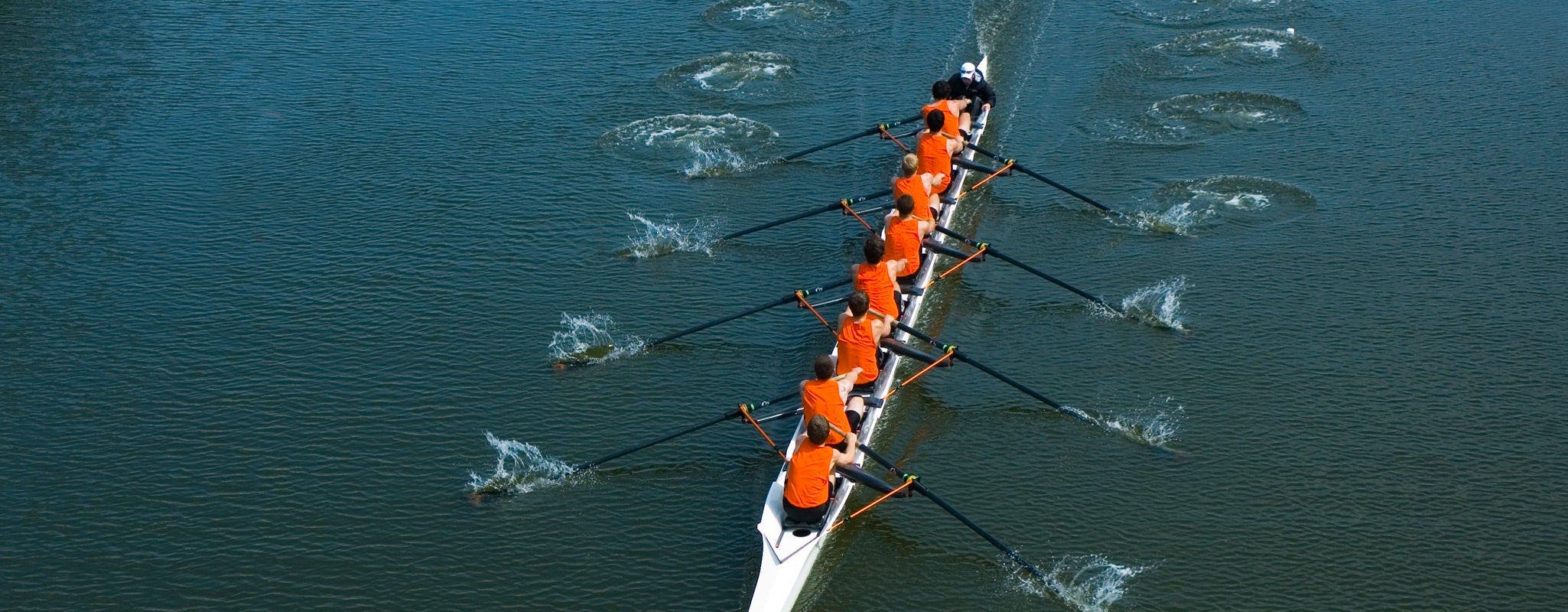Ready, set...Row


With the weather finally turning, it’s time to head outdoors. However, instead of taking to the hills or the road this spring and summer, try getting on the water for a world-class workout.
Rowing, either alone or with a crew of two, four or eight teammates, is one of the most effective ways to improve your health and lose weight. Because it activates all the major muscle groups—the legs, back, core and arms—as well as the cardiovascular system, rowing burns upwards of 20 percent more calories than swimming or running, according to Ohio University’s Dr. Fritz Hagerman, who has been testing rowers’ fitness levels for nearly half a century. So, to meet your weight and health ambitions this coming season, follow these six steps to the water.
Step 1: Find a venue
Rowing equipment can be prohibitively expensive, so finding a venue where you can rent equipment is paramount. Luckily, either through corporate rowing events, learn-to-row programs or simply a local boathouse that rents boats (shells, in rowing terms), where there's water there's usually an affordable way to get on it. Check the Web site of the United States Rowing Association (www.USrowing.org) to find out where the closest club to you is, and, if at all possible, get a group to join you. Rowing is easier in larger groups, and the team atmosphere will help you commit to the goal of keeping at it.
"The team aspect of rowing is tremendous," says three-time Canadian Olympian Dave Calder, a Silver Medalist from the 2008 Beijing Games. Calder suggests that by creating a weekly schedule as a group, you're less likely to miss a workout. "It helps you commit to your goal of getting on the water—whether to train for the Olympics or just to feel good about yourself."
Step 2: Get cleared by your doctor
Before you start, be sure to get cleared by your doctor. Rowing is a sport that works the entire body, so you'll want to be sure it's safe to participate before you steam ahead. If you have a history of back problems, be extra cautious when you head onto the water.
Step 3: Get prepared
Starting rowing cold turkey isn't a great idea: you'll be using some long-dormant muscles, so gradually building up to the real thing is the best course of action. Luckily, most fitness clubs have a machine that simulates rowing (without the enjoyment of the fresh outdoor air, of course)—that thing in the corner with a moving seat that you sit on while pulling a handle attached to a chain and flywheel. Before you take to the water, be sure to get on this machine a few times. By holding the handle with an overhand grip and then pushing first with the legs, then the back and then the arms, you will be replicating the basic rowing motion that you'll later use on the water.
You'll also want to get the appropriate gear for when you start to row. Traditionally, serious rowers wear tight suits to avoid getting clothing caught in the shell's moving parts; for the beginner however, tighter-fitting workout clothing will suffice. Be sure to also prepare for the weather. "Dress appropriately for the day," says Marlene Royle, coach at the Florida Rowing Center. "Listen to the weather report to know if you are expecting rain, high winds, hot temperatures or a cold front." In any weather, avoid clothes made of cotton and instead don lighter, less absorbent fabrics that won't soak up water and make you cold.
Step 4: Warm up
When you're about to head onto the water, be sure to warm up to avoid being stiff and sore the following day. "Spend about 15 minutes doing some light aerobic activity such as jogging, spinning on a stationary bike or rowing on a rowing machine," suggest Royle, "and spend a few minutes stretching before you get in your boat." Stretches that loosen up the hamstrings and lower back are the most important and will help protect against injury.
Step 5: Take a lesson
While rowing may look simple on television or from shore, you'll quickly be swimming instead of rowing without some instruction. Lessons are almost always offered at places where boats are rented, and they are usually done in groups (all the better to meet people and, as Calder notes, help you stay motivated). In hopes of keeping you dry, a coach will show you how to balance the boat, what the basic rowing movements are and how to be safe on the water. As you progress beyond the basics, the coach will likely help tailor your workouts to meet your specific goals.
Step 6: Stick with it
Although rowing can at first seem less than natural, those who stick with it will be handsomely rewarded with increased fitness levels, weight loss (when coupled with a healthy eating regimen) and an appreciation for one of the most serene outdoor activities around. Whether you progress to the point where you want to race others, or just enjoy a light paddle on the lake, rowing is an effective and fun way to meet your fitness and weight-loss goals.
About the writer
Kip McDaniel is a former Canadian national team rower and well-known in the world of elite crew for losing 40 pounds in the five months before winning a bronze medal at the 2005 World Championships. Retired from rowing, Kip is now a financial writer in Boston, MA.
